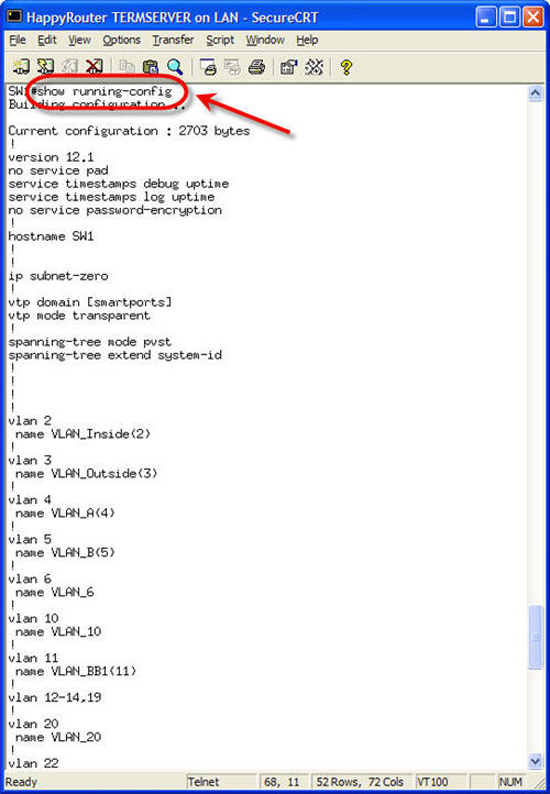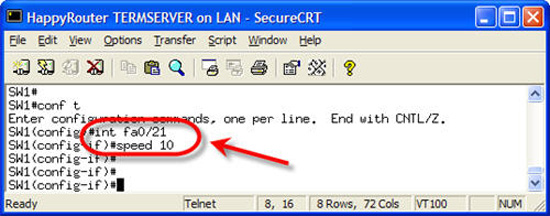The basics of Cisco Switch Management - Part 1
TipsMake.com - Sometimes, you will have to configure a switch port or find the MAC address on each port. Maybe, this is not what you do on a daily basis and need a basic course on Cisco's Switch administration position. So, try to explore the basic steps of this position.
Log in
Before you can administer the Switch, you need to know some basic information:
• What switch IP address? What is DNS?
• Can you login and password?
• Ethernet port of switch
One way to configure the switch is to configure it on the web interface. Basic configuration is not difficult and you do not need much help. In the command-line interface CLI (command-line interface) you can perform any type of configuration. Therefore, I recommend that you use the IOS command line interface. In this article we will take the basic steps of managing switches with the Cisco IOS command-line interface.
Show switch configuration
Just like on a router, the IOS command is used to display the switch configuration with all Ethernet ports. To know the configuration of the switch, just type show running-config as follows:

Show port status
Almost every time you switch to the switch, you must troubleshoot the switch port or change the switch port configuration. The quickest way to display the status of each switch port is to show show interfaces status :

This command is displayed: if the port is connected to the device, the VLAN is IN, displayed with the speed and model of the port. This is the fastest and best way to know the status of each switch port.
Change the speed and duplex of the interface
Interface Fa0 / 21 with the speed set to auto. However, this speed needs to be set to 10Mb / sec. To change the speed of the ports, go to interface configuration mode and use the speed command :

On this switch, the speed of 10/100 Ethernet ports is set to auto, 10 and 100. On the Gigabit Ethernet port you can only adjust the switch with the port speed being able or not able to detect the speed yourself. Once the speed is configured to 10Mb, you can check the interface Fa0 / 21 again like:

As you can see, the speed has been set to 10. To change the speed of both directions of the port, you perform the same step, but use the duplex command. Duplex can be set to auto , full or half .
Turn off and turn on interfaces
To enable or disable interfaces, you use the no shutdown / shutdown command in interface configuration mode. Here is an example:

Note that when the port is shut down, the communication message appears telling you that the management status has been changed to down , the line protocol is also converted to down . When the port is turned on, the line protocol will switch to up .
Now you can display the interface status to see its status.
You should read it
- List the default password of Cisco routers and switches
- How to use PuTTY on Cisco routers and switches
- 5 best Cisco network device monitoring tools
- The basics of Cisco Switch Management - Part 2
- 4 places to help you learn skills and get Cisco certification
- Changes in the CCNP exam
- Set up Wi-Fi network only 3 steps
- What is network administrator doing? Need to learn what?
May be interested
- 4 places to help you learn skills and get Cisco certification
 options will include online courses, online teachers and instructional software.
options will include online courses, online teachers and instructional software. - Instructions for configuring Cisco routers
 in this article we will provide you with a reference and reference material on configuring cisco routers. the method of configuring the cisco router used in the lesson is through the ios command line interface.
in this article we will provide you with a reference and reference material on configuring cisco routers. the method of configuring the cisco router used in the lesson is through the ios command line interface. - 7 Cisco security tips
 cisco has just released its first annual security report with the launch of cisco security center website (cisco.com/security). the report also makes predictions about security threats in 2008 along with advice from security experts.
cisco has just released its first annual security report with the launch of cisco security center website (cisco.com/security). the report also makes predictions about security threats in 2008 along with advice from security experts. - 10 commands to master when working with Cisco IOS
 if you want to master the cisco ios, you need to learn some necessary commands. the following article will summarize 10 useful commands to handle various troubleshooting and configuration tasks.
if you want to master the cisco ios, you need to learn some necessary commands. the following article will summarize 10 useful commands to handle various troubleshooting and configuration tasks. - List the default password of Cisco routers and switches
 the default cisco password will give you access to the router's administration interface and make changes to your security settings or change your wifi password. most cisco routers and switches have a default password of admin or cisco and the default ip address is 192.168.1.1 or 192.168.1.254.
the default cisco password will give you access to the router's administration interface and make changes to your security settings or change your wifi password. most cisco routers and switches have a default password of admin or cisco and the default ip address is 192.168.1.1 or 192.168.1.254. - Cisco Router Configuration Guide 1800 series (Cisco 1801, 1802, 1803, 1811, 1812)
 this article will show you how to configure cisco 1800 series routers (cisco 1801, 1802, 1803, 1811, 1812) details from global parameter settings, routing, interface protocols, and command line access.
this article will show you how to configure cisco 1800 series routers (cisco 1801, 1802, 1803, 1811, 1812) details from global parameter settings, routing, interface protocols, and command line access. - Cisco CCNA command synthesis
 the article will try to synthesize ccna commands in both icnd parts 1 and 2 as well as the current ccna exam (640-802).
the article will try to synthesize ccna commands in both icnd parts 1 and 2 as well as the current ccna exam (640-802). - How to Configure a Cisco Router
 this wikihow teaches you how to set up a cisco small business router on your local network. to get started, you'll need to connect to the router with a console cable and enable a web-based administration tool called cisco configuration...
this wikihow teaches you how to set up a cisco small business router on your local network. to get started, you'll need to connect to the router with a console cable and enable a web-based administration tool called cisco configuration... - What is VLAN? How to configure a VLAN on Cisco Switch?
 have you ever asked yourself questions like virtual lan or vlan? when and why do you need a vlan?
have you ever asked yourself questions like virtual lan or vlan? when and why do you need a vlan? - 5 things you should know when configuring a Cisco IOS switch
 most switches that are commonly used in small businesses and at home are places that do not require configuration - they are 'plug and play' compliant. however, it is very important to keep in mind that sometimes 'plug and play' doesn't always work. ngo & agrav
most switches that are commonly used in small businesses and at home are places that do not require configuration - they are 'plug and play' compliant. however, it is very important to keep in mind that sometimes 'plug and play' doesn't always work. ngo & agrav










 6 problems with routers and solutions to overcome
6 problems with routers and solutions to overcome The basics of Cisco Switch Management - Part 2
The basics of Cisco Switch Management - Part 2 Share your Internet connection through the ad hoc network in Windows 7
Share your Internet connection through the ad hoc network in Windows 7 Create a private VPN Server with DD-WRT
Create a private VPN Server with DD-WRT Share Windows in Mac OS X
Share Windows in Mac OS X Troubleshoot Mac network problems
Troubleshoot Mac network problems